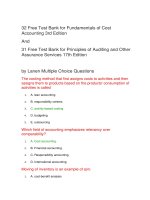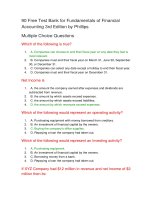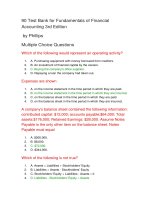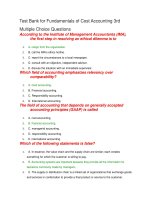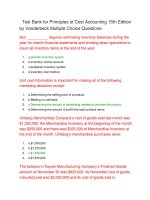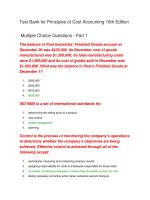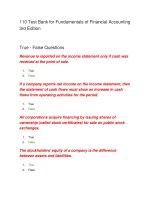63 test bank of fundamentals of cost accounting 3rd edition
Bạn đang xem bản rút gọn của tài liệu. Xem và tải ngay bản đầy đủ của tài liệu tại đây (81.92 KB, 19 trang )
32 Free Test Bank for Fundamentals of Cost
Accounting 3rd Edition
And
31 Free Test Bank for Principles of Auditing and Other
Assurance Services 17th Edition
by Lanen Multiple Choice Questions
The costing method that first assigns costs to activities and then
assigns them to products based on the products' consumption of
activities is called
1.
A. lean accounting
2.
B. responsibility centers
3.
C. activity-based costing
4.
D. budgeting
5.
E. outsourcing
Which field of accounting emphasizes relevancy over
comparability?
1.
A. Cost accounting.
2.
B. Financial accounting.
3.
C. Responsibility accounting.
4.
D. International accounting.
Moving of inventory is an example of a(n)
1.
A. cost-benefit analysis
2.
B. value-added activity
3.
C. activity-based cost
4.
D. nonvalue-added activity
Continual process of measuring a company's own products,
services or activities against competitors' performance is
1.
A. performance measure
2.
B. benchmarking
3.
C. budgeting
4.
D. responsibility center
5.
E. lean accounting
Which of the following statements is false?
1.
A. In essence, the value chain and the supply chain are similar; each
creates something for which the customer is willing to pay.
2.
B. Accounting systems are important because they provide all the
information for decisions commonly made by managers.
3.
C. The supply or distribution chain is a linked set of organizations that
exchange goods and services in combination to provide a final product or
service to the customer.
4.
D. Eliminating nonvalue-added activities always reduces costs without
affecting the value of the product to customers.
5.
the accounting system does not provide ALL of the information needed
The cost accounting system that minimizes wasteful or
unnecessary transaction processes is
1.
A. performance measure
2.
B. benchmarking
3.
C. budgeting
4.
D. responsibility center
5.
E. lean accounting
The set of activities that transforms raw resources into the goods
and services of an organization is called:
1.
A. Value chain.
2.
B. Supply chain.
3.
C. Demand chain.
4.
D. Cost-benefit analysis.
An accounting system that collects financial and operating data
on the basis of the underlying nature and extent of cost drivers is
(CMA adapted)
1.
A. full-absorption costing.
2.
B. activity-based costing.
3.
C. variable costing.
4.
D. benchmarking.
Costs that change in response to a particular course of action are
1.
A. differential costs
2.
B. cost-benefit analysis
3.
C. activity-based costs
4.
D. cost drivers
The financial plan of the revenues and resources needed to carry
out activities and meet financial goals is called
1.
A. performance measure
2.
B. benchmarking
3.
C. budgeting
4.
D. responsibility center
5.
E. lean accounting
Information technology that links the various processes of the
company into a single comprehensive information system is
called
1.
A. customer relationship management
2.
B. distribution chain
3.
C. total quality management
4.
D. cost of quality
5.
E. enterprise resource planning
Which of the following is a nonvalue-added activity?
1.
A. Product design
2.
B. Customer service
3.
C. Research and development
4.
D. Rework of defective items
Which of the following is not normally considered part of the value
chain?
1.
A. Research and development
2.
B. Purchasing
3.
C. Administration
4.
D. Distribution
5.
E. Customer service
Managers do not make decisions about future events based on:
1.
A. Perfect information.
2.
B. Estimated information.
3.
C. Actual information.
4.
D. Financial information.
5.
E. Cost information.
The JKL Restaurant had sales revenues and food costs in 2009
of $800,000 and $600,000, respectively. In 2010, JKL will be
introducing a new menu item that will generate $100,000 in sales
revenues and $40,000 in food costs. Assuming no changes are
expected for the other food items, the differential operating profit
for 2010 is
1.
A. $260,000.
2.
B. $100,000.
3.
C. $60,000.
4.
D. $40,000.
According to the Institute of Management Accountants (IMA), the
first step in resolving an ethical dilemma is to
1.
A. resign from the organization.
2.
B. call the IMA's ethics hotline.
3.
C. report the circumstances to a local newspaper.
4.
D. consult with an objective, independent advisor.
5.
E. discuss the situation with an immediate supervisor.
Which of the following is not one of the basic standards of the
Institute of Management Accountants (IMA) Code of Ethics?
1.
A. Competence
2.
B. Confidentiality
3.
C. Honesty
4.
D. Integrity
5.
E. Credibility
The field of accounting that depends on generally accepted
accounting principles (GAAP) is called
1.
A. cost accounting.
2.
B. financial accounting.
3.
C. managerial accounting.
4.
D. responsibility accounting.
5.
E. international accounting.
A management method by which the organization seeks to excel
on all dimensions of quality is called
1.
A. customer relationship management
2.
B. distribution chain
3.
C. total quality management
4.
D. cost of quality
5.
E. enterprise resource planning
The system that identifies the costs of producing low-quality items
is called
1.
A. customer relationship management
2.
B. distribution chain
3.
C. total quality management
4.
D. cost of quality
5.
E. enterprise resource planning
In 2010, the Turnkey Company had consulting revenues of
$1,000,000 while costs were $750,000. In 2011, Turnkey will be
introducing a new service that will generate $150,000 in sales
revenues and $60,000 in costs. Assuming no changes are
expected for the other services, the differential operating profit for
2011 is
1.
A. $250,000.
2.
B. $150,000.
3.
C. $90,000.
4.
D. $60,000.
The process of creating a formal plan and translating goals into a
quantitative format is (CMA adapted)
1.
A. budgeting.
2.
B. benchmarking.
3.
C. cost-benefit analysis.
4.
D. value-added analysis.
5.
E. activity-based costing.
Which of the following activities would not be considered a valueadded activity?
1.
A. Production
2.
B. Marketing
3.
C. Accounting
4.
D. Distribution
According to the Institute of Management Accountants (IMA), the
final step in resolving an ethical dilemma is to
1.
A. resign from the organization.
2.
B. call the IMA's ethics hotline.
3.
C. report the circumstances to a local newspaper.
4.
D. consult with an objective, independent advisor.
5.
E. discuss the situation with an immediate supervisor.
In 2010, the MoreForLess Company had revenues of $2,000,000
while costs were $1,500,000. In 2011, MoreForLess will be
introducing a new product line that will generate $200,000 in
sales revenues and $160,000 in costs. Assuming no changes are
expected for the other products, the differential operating profit for
2011 is
1.
A. $540,000.
2.
B. $200,000.
3.
C. $160,000.
4.
D. $40,000.
The primary reason for adopting total quality management (TQM)
is to achieve (CIA adapted)
1.
A. reduced delivery time.
2.
B. reduced delivery charges.
3.
C. greater customer satisfaction.
4.
D. greater employee participation.
5.
E. better managerial decisions.
The system that allows firms to target profitable customers by
assessing customer revenue and costs is called
1.
A. customer relationship management
2.
B. distribution chain
3.
C. total quality management
4.
D. cost of quality
5.
E. enterprise resource planning
Which of the following is not one of the overarching ethical
principles of the Institute of Management Accountants (IMA) Code
of Ethics?
1.
A. Competence
2.
B. Responsibility
3.
C. Honesty
4.
D. Objectivity
5.
E. Fairness
Having one or more of the firms' activities performed by another
firm or individual in the supply or distribution chain is called
1.
A. lean accounting
2.
B. responsibility centers
3.
C. activity-based costing
4.
D. budgeting
5.
E. outsourcing
Cost drivers are (CMA adapted)
1.
A. activities that cause costs to increase as the activity increases.
2.
B. accounting techniques and practices used to control costs.
3.
C. accounting reimbursements used to evaluate whether performance is
proceeding according to plan.
4.
D. a mechanical basis, such as machine hours, computer time, or factory
square footage, used to assign costs to activities.
Which of the following is not a key financial manager in an
organization?
1.
A. Chief financial officer
2.
B. Treasurer
3.
C. External auditor
4.
D. Controller
5.
E. Cost accountant
The just-in-time (JIT) methods of production focuses on
1.
A. increasing sales revenue.
2.
B. reducing inventories.
3.
C. increasing customer service.
4.
D. reducing operating expenses.
5.
E. increasing product quality.
31 Free Test Bank for Principles of Auditing and Other
Assurance Services 17th Edition by Whittington
Multiple Choice Questions
The FDIC Improvement Act requires that management of large
financial institutions engage auditors to attest to assertions by
management about the effectiveness of the institution's internal
controls over
1.
A. Compliance with laws and regulations.
2.
B. Financial reporting.
3.
C. Effectiveness of operations.
4.
D. Efficiency of operations.
The risk associated with a company's survival and profitability is
referred to as:
1.
A. Business Risk.
2.
B. Information Risk.
3.
C. Detection Risk.
4.
D. Control Risk.
The attest function:
1.
A. Is an essential part of every engagement by the CPA, whether
performing auditing, tax work, or other services.
2.
B. Includes the preparation of a report of the CPA's findings.
3.
C. Requires a consideration of internal control.
4.
D. Requires a complete review of all transactions during the period under
examination.
Attestation risk is limited to a low level in which of the following
engagement(s)?
1.
A. Both examinations and reviews.
2.
B. Examinations, but not reviews.
3.
C. Reviews, but not examinations.
4.
D. Neither examinations nor reviews.
An integrated audit performed under the Sarbanes-Oxley Act
requires that auditors report on: Financial Statements: A)Yes; B)
Yes; C) No; D) No. Internal Control: A)Yes; B) No; C) Yes; D) No.
1.
A. Option A
2.
B. Option B
3.
C. Option C
4.
D. Option D
An operational audit differs in many ways from an audit of
financial statements. Which of the following is the best example of
one of these differences?
1.
A. The usual audit of financial statements covers the four basic statements,
whereas the operational audit is usually limited to either the balance sheet or
the income statement.
2.
B. The boundaries of an operational audit are often drawn from an
organization chart and are not limited to a single accounting period.
3.
C. Operational audits do not ordinarily result in the preparation of a report.
4.
D. The operational audit deals with pre-tax income.
Which of the following terms best describes the audit of a
taxpayer's tax return by an IRS auditor?
1.
A. Operational audit.
2.
B. Internal audit.
3.
C. Compliance audit.
4.
D. Government audit.
Governmental auditing often extends beyond examinations
leading to the expression of opinion on the fairness of financial
presentation and includes audits of efficiency, economy,
effectiveness, and also:
1.
A. Accuracy.
2.
B. Evaluation.
3.
C. Compliance.
4.
D. Internal control.
When compared to an audit performed prior to 1900, an audit
today:
1.
2.
A. Is more likely to include tests of compliance with laws and regulations.
B. Is less likely to include consideration of the effectiveness of internal
control.
3.
C. Has bank loan officers as the primary financial statement user group.
4.
D. Includes a more detailed examination of all individual transactions.
Which statement is correct with respect to continuing professional
education (CPE) requirements of members of the AICPA?
1.
2.
3.
4.
A. Only members employed by the AICPA are required to take such
courses.
B. Only members in public practice are required to take such courses.
C. Members, regardless of whether they are in public practice, are required
to meet such requirements.
D. There is no requirement for members to participate in CPE.
Which of the following is not correct relating to the SarbanesOxley Act?
1.
A. It toughens penalties for corporate fraud.
2.
B. It restricts the types of consulting CPAs may perform for audit clients.
3.
C. It created the Public Company Accounting Oversight Board (PCAOB) as
a replacement for the Financial Accounting Standards Board.
4.
D. It eliminates a significant portion of the accounting profession's system
of self-regulation.
The Statements on Auditing Standards have been issued by the:
1.
A. Auditing Standards Board.
2.
B. Financial Accounting Standards Board.
3.
C. Securities and Exchange Commission.
4.
D. Federal Bureau of Investigation.
Historically, which of the following has the AICPA been most
concerned with providing?
1.
A. Professional standards for CPAs.
2.
B. Professional guidance for regulating financial markets.
3.
C. Standards guiding the conduct of internal auditors.
4.
D. Staff support to Congress.
A typical objective of an operational audit is for the auditor to:
1.
A. Determine whether the financial statements fairly present the entity's
operations.
2.
B. Evaluate the feasibility of attaining the entity's operational objectives.
3.
C. Make recommendations for improving performance.
4.
D. Report on the entity's relative success in attaining profit maximization.
Passage of the Sarbanes-Oxley Act led to the establishment of
the:
1.
A. Auditing Standards Board.
2.
B. Accounting Enforcement Releases Board.
3.
C. Public Company Accounting Oversight Board.
4.
D. Securities and Exchange Commission.
Which of the following attributes most clearly differentiates a CPA
who audits management's financial statements as contrasted to
management?
1.
A. Integrity.
2.
B. Competence.
3.
C. Independence.
4.
D. Keeping informed on current professional developments.
Inquiries and analytical procedures ordinarily form the basis for
which type of engagement?
1.
A. Agreed-upon procedures.
2.
B. Audit.
3.
C. Examination.
4.
D. Review.
A summary of findings rather than assurance is most likely to be
included in a(n):
1.
A. Agreed-upon procedures report.
2.
B. Compilation report.
3.
C. Examination report.
4.
D. Review report.
Which of the following types of services is generally provided only
by CPA firms?
1.
A. Tax audits.
2.
B. Financial statement audits.
3.
C. Compliance audits.
4.
D. Operational audits.
The Government Accountability Office (GAO):
1.
A. Is primarily concerned with rapid processing of all accounts payable
incurred by the federal government.
2.
B. Conducts operational audits and reports the results to Congress.
3.
C. Is a multinational organization of professional accountants.
4.
D. Is primarily concerned with budgets and forecasts approved by the SEC.
An engagement in which a CPA firm arranges for a critical review
of its practices by another CPA firm is referred to as a(n):
1.
A. Peer Review Engagement.
2.
B. Quality Control Engagement.
3.
C. Quality Assurance Engagement.
4.
D. Attestation Engagement.
The risk that information is misstated is referred to as:
1.
A. Information risk.
2.
B. Inherent risk.
3.
C. Relative risk.
4.
D. Business risk.
The serially-numbered pronouncements issued by the Auditing
Standards Board over a period of years are known as:
1.
A. Auditing Statements of Position (ASPs).
2.
B. Accounting Series Releases (ASRs).
3.
C. Statements on Auditing Standards (SASs).
4.
D. Statements on Auditing Principles (SAPs).
The risk that a company will not be able to meet its obligations
when they become due is referred to as:
1.
A. Information risk.
2.
B. Inherent risk.
3.
C. Relative risk.
4.
D. Business risk.
The review of a company's financial statements by a CPA firm:
1.
A. Is substantially less in scope of procedures than an audit.
2.
B. Requires detailed analysis of the major accounts.
3.
C. Is of similar scope as an audit and adds similar credibility to the
statements.
4.
D. Culminates in issuance of a report expressing the CPA's opinion as to
the fairness of the statements.
The right to practice as a CPA is given by which of the following
organizations?
1.
A. State Boards of Accountancy.
2.
B. The AICPA.
3.
C. The SEC.
4.
D. The General Accounting Office.
The organization charged with protecting investors and the public
by requiring full disclosure of financial information by companies
offering securities to the public is the:
1.
A. Auditing Standards Board.
2.
B. Financial Accounting Standards Board.
3.
C. Government Accounting Standards Boards.
4.
D. Securities and Exchange Commission.
Which of the following are issued by the Securities and Exchange
Commission?
1.
A. Accounting Research Studies.
2.
B. Accounting Trends and Techniques.
3.
C. Industry Audit Guides.
4.
D. Financial Reporting Releases.
Which of the following best describes the reason why
independent auditors report on financial statements?
1.
A. A management fraud may exist and it is more likely to be detected by
independent auditors.
2.
B. Different interests may exist between the company preparing the
statements and the persons using the statements.
3.
C. A misstatement of account balances may exist and is generally
corrected as the result of the independent auditors' work.
4.
D. Poorly designed internal control may be in existence.
Which of the following professionals has primary responsibility for
the performance of an audit?
1.
A. The managing partner of the firm.
2.
B. The senior assigned to the engagement.
3.
C. The manager assigned to the engagement.
4.
D. The partner in charge of the engagement.
Operational auditing is primarily oriented toward:
1.
A. Future improvements to accomplish the goals of management.
2.
B. The accuracy of data reflected in management's financial records.
3.
4.
C. The verification that a company's financial statements are fairly
presented.
D. Past protection provided by existing internal control.
